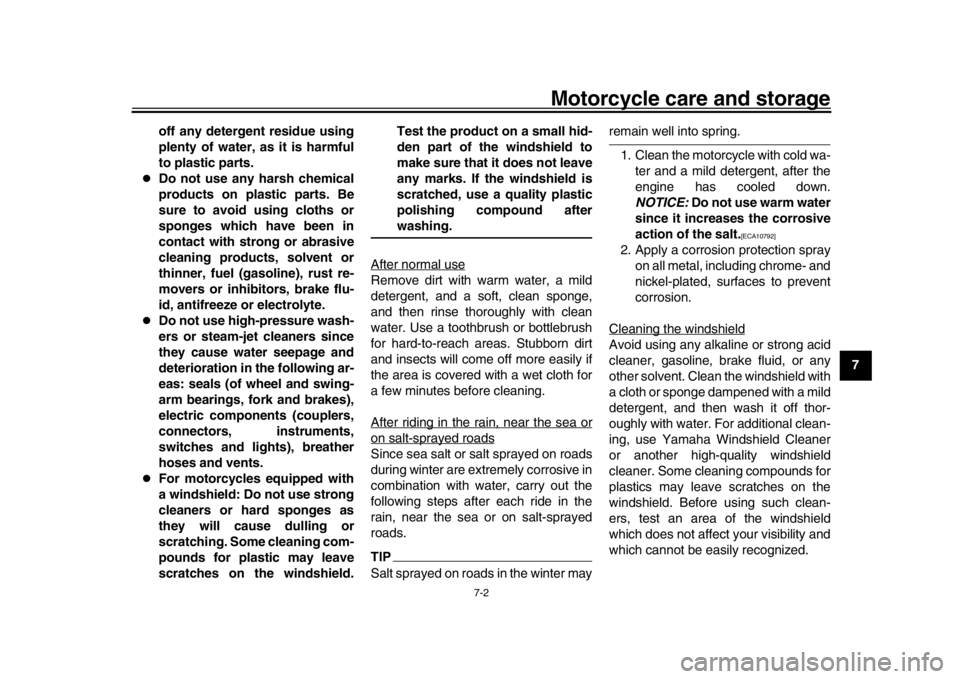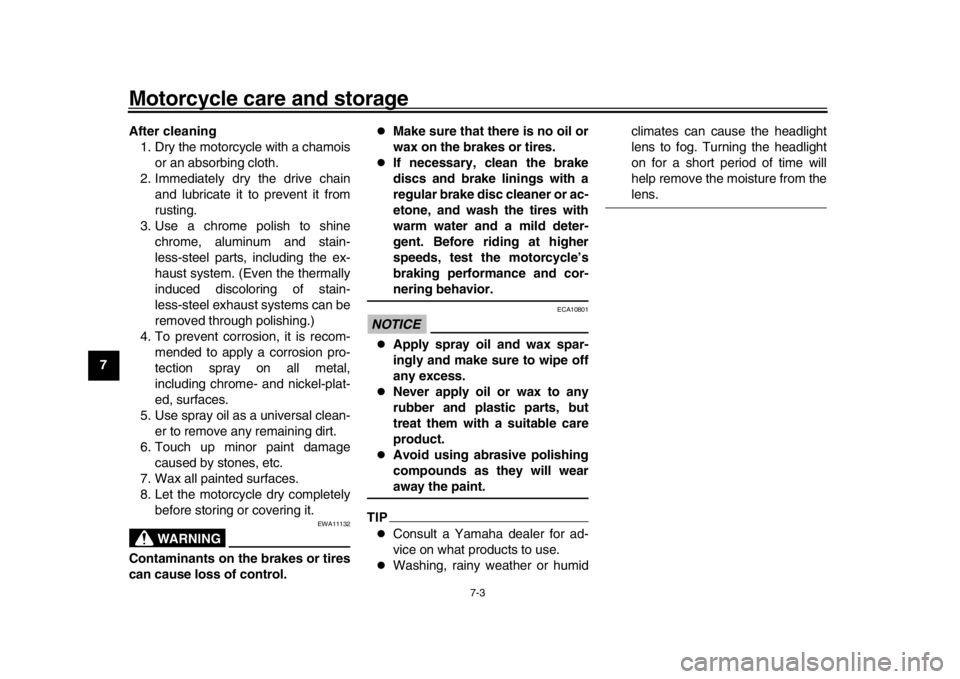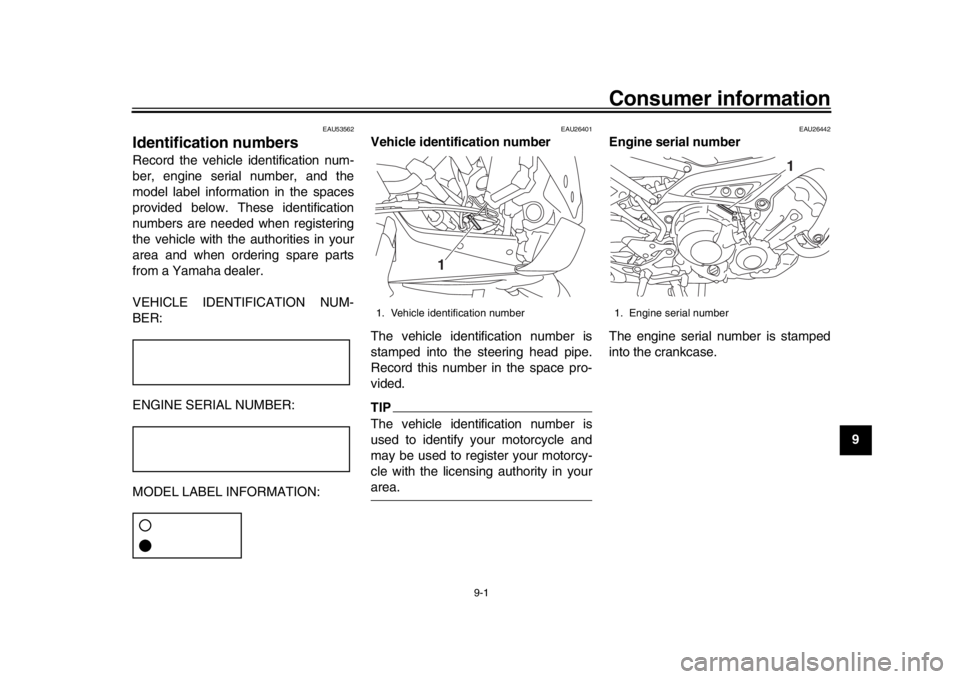YAMAHA MT09 TRACER 2017 Owners Manual
Manufacturer: YAMAHA, Model Year: 2017, Model line: MT09 TRACER, Model: YAMAHA MT09 TRACER 2017Pages: 114, PDF Size: 5.27 MB
Page 101 of 114

Periodic maintenance and adjustment6-40
1
2
3
4
567
8
9
10
11
12
Engine overheating
WARNING
EWA10401
Do not remove the radiator cap when the engine and radiator are hot. Scalding hot fluid and steam may be
blown out under pressure, which could cause serious injury. Be sure to wait until the engine has cooled.
After removing the radiator cap retaining bolt, place a thick rag, like a towel, over the radiator cap, and then
slowly rotate the cap counterclockwise to the detent
to allow any residual pressure to escape. When the hissingsound has stopped, press down on the cap while turning it counterclockwise, and then remove the cap.
TIPIf coolant is not available, tap water can be temporarily used instead, provided that it is changed to the recommended coolantas soon as possible.
Wait until the
engine has cooled.
Check the coolant level in the
reservoir and radiator.
The coolant level
is OK.The coolant level is low.
Check the cooling system
for leakage.
Have a Yamaha dealer checkand repair the cooling system.Add coolant. (See TIP.)
Start the engine. If the engine overheats again,
have a
Yamaha dealer check
and repair the cooling system.
There is
leakage.
There is
no leakage.
2PP-9-E3.book 40 ページ 2016年9月13日 火曜日 午前9時7分
Page 102 of 114

7-1
1
2
3
4
5
67
8
9
10
11
12
Motorcycle care and storage
EAU37834
Matte color cautionNOTICE
ECA15193
Some models are equipped with
matte colored finished parts. Be
sure to consult a Yamaha dealer for
advice on what products to use be-
fore cleaning the vehicle. Using a
brush, harsh chemical products or
cleaning compounds when cleaning
these parts will scratch or damage
their surface. Wax also should not
be applied to any matte colored fin-ished parts.
EAU54661
CareWhile the open design of a motorcycle
reveals the attractiveness of the tech-
nology, it also makes it more vulnera-
ble. Rust and corrosion can develop
even if high-quality components are
used. A rusty exhaust pipe may go un-
noticed on a car, however, it detracts
from the overall appearance of a motor-
cycle. Frequent and proper care does
not only comply with the terms of the
warranty, but it will also keep your mo-
torcycle looking good, extend its life
and optimize its performance.
Before cleaning 1. Cover the muffler outlet with a plastic bag after the engine has
cooled down.
2. Make sure that all caps and covers as well as all electrical couplers
and connectors, including the
spark plug caps, are tightly in-
stalled.
3. Remove extremely stubborn dirt, like oil burnt onto the crankcase,
with a degreasing agent and a
brush, but never apply such prod- ucts onto seals, gaskets, sprock-
ets, the drive chain and wheel
axles. Always rinse the dirt and de-
greaser off with water.
Cleaning
NOTICE
ECA10773
Avoid using strong acidic wheel
cleaners, especially on spoked
wheels. If such products are
used on hard-to-remove dirt, do
not leave the cleaner on the af-
fected area any longer than in-
structed. Also, thoroughly rinse
the area off with water, immedi-
ately dry it, and then apply a cor-
rosion protection spray.
Improper cleaning can damage
plastic parts (such as cowlings,
panels, windshields, headlight
lenses, meter lenses, etc.) and
the mufflers. Use only a soft,
clean cloth or sponge with wa-
ter to clean plastic. However, if
the plastic parts cannot be thor-
oughly cleaned with water, di-
luted mild detergent with water
may be used. Be sure to rinse
2PP-9-E3.book 1 ページ 2016年9月13日 火曜日 午前9時7分
Page 103 of 114

Motorcycle care and storage
7-2
1
2
3
4
5
678
9
10
11
12
off any detergent residue using
plenty of water, as it is harmful
to plastic parts.
Do not use any harsh chemical
products on plastic parts. Be
sure to avoid using cloths or
sponges which have been in
contact with strong or abrasive
cleaning products, solvent or
thinner, fuel (gasoline), rust re-
movers or inhibitors, brake flu-
id, antifreeze or electrolyte.
Do not use high-pressure wash-
ers or steam-jet cleaners since
they cause water seepage and
deterioration in the following ar-
eas: seals (of wheel and swing-
arm bearings, fork and brakes),
electric components (couplers,
connectors, instruments,
switches and lights), breather
hoses and vents.
For motorcycles equipped with
a windshield: Do not use strong
cleaners or hard sponges as
they will cause dulling or
scratching. Some cleaning com-
pounds for plastic may leave
scratches on the windshield. Test the product on a small hid-
den part of the windshield to
make sure that it does not leave
any marks. If the windshield is
scratched, use a quality plastic
polishing compound after
washing.
After normal use
Remove dirt with warm water, a mild
detergent, and a soft, clean sponge,
and then rinse thoroughly with clean
water. Use a toothbrush or bottlebrush
for hard-to-reach areas. Stubborn dirt
and insects will come off more easily if
the area is covered with a wet cloth for
a few minutes before cleaning.
After riding in the rain, near the sea oron salt-sprayed roadsSince sea salt or salt sprayed on roads
during winter are extremely corrosive in
combination with water, carry out the
following steps after each ride in the
rain, near the sea or on salt-sprayed
roads.TIPSalt sprayed on roads in the winter may
remain well into spring. 1. Clean the motorcycle with cold wa- ter and a mild detergent, after the
engine has cooled down.
NOTICE: Do not use warm water
since it increases the corrosive
action of the salt.
[ECA10792]
2. Apply a corrosion protection spray on all metal, including chrome- and
nickel-plated, surfaces to prevent
corrosion.
Cleaning the windshieldAvoid using any alkaline or strong acid
cleaner, gasoline, brake fluid, or any
other solvent. Clean the windshield with
a cloth or sponge dampened with a mild
detergent, and then wash it off thor-
oughly with water. For additional clean-
ing, use Yamaha Windshield Cleaner
or another high-quality windshield
cleaner. Some cleaning compounds for
plastics may leave scratches on the
windshield. Before using such clean-
ers, test an area of the windshield
which does not affect your visibility and
which cannot be easily recognized.
2PP-9-E3.book 2 ページ 2016年9月13日 火曜日 午前9時7分
Page 104 of 114

Motorcycle care and storage
7-3
1
2
3
4
5
67
8
9
10
11
12 After cleaning
1. Dry the motorcycle with a chamois or an absorbing cloth.
2. Immediately dry the drive chain and lubricate it to prevent it from
rusting.
3. Use a chrome polish to shine chrome, aluminum and stain-
less-steel parts, including the ex-
haust system. (Even the thermally
induced discoloring of stain-
less-steel exhaust systems can be
removed through polishing.)
4. To prevent corrosion, it is recom- mended to apply a corrosion pro-
tection spray on all metal,
including chrome- and nickel-plat-
ed, surfaces.
5. Use spray oil as a universal clean- er to remove any remaining dirt.
6. Touch up minor paint damage caused by stones, etc.
7. Wax all painted surfaces.
8. Let the motorcycle dry completely before storing or covering it.
WARNING
EWA11132
Contaminants on the brakes or tires
can cause loss of control.
Make sure that there is no oil or
wax on the brakes or tires.
If necessary, clean the brake
discs and brake linings with a
regular brake disc cleaner or ac-
etone, and wash the tires with
warm water and a mild deter-
gent. Before riding at higher
speeds, test the motorcycle’s
braking performance and cor-nering behavior.
NOTICE
ECA10801
Apply spray oil and wax spar-
ingly and make sure to wipe off
any excess.
Never apply oil or wax to any
rubber and plastic parts, but
treat them with a suitable care
product.
Avoid using abrasive polishing
compounds as they will wearaway the paint.
TIP
Consult a Yamaha dealer for ad-
vice on what products to use.
Washing, rainy weather or humid climates can cause the headlight
lens to fog. Turning the headlight
on for a short period of time will
help remove the moisture from the
lens.
2PP-9-E3.book 3 ページ 2016年9月13日 火曜日 午前9時7分
Page 105 of 114

Motorcycle care and storage
7-4
1
2
3
4
5
678
9
10
11
12
EAU26183
StorageShort-term
Always store your motorcycle in a cool,
dry place and, if necessary, protect it
against dust with a porous cover. Be
sure the engine and the exhaust sys-
tem are cool before covering the motor-
cycle.NOTICE
ECA10811
Storing the motorcycle in a
poorly ventilated room or cover-
ing it with a tarp, while it is still
wet, will allow water and humid-
ity to seep in and cause rust.
To prevent corrosion, avoid
damp cellars, stables (because
of the presence of ammonia)
and areas where strong chemi-cals are stored.
Long-term
Before storing your motorcycle for sev-
eral months: 1. Follow all the instructions in the “Care” section of this chapter. 2. Fill up the fuel tank and add fuel
stabilizer (if available) to prevent
the fuel tank from rusting and the
fuel from deteriorating.
3. Perform the following steps to pro- tect the cylinders, piston rings, etc.
from corrosion.
a. Remove the spark plug caps and spark plugs.
b. Pour a teaspoonful of engine oil into each spark plug bore.
c. Install the spark plug caps onto the spark plugs, and then place
the spark plugs on the cylinder
head so that the electrodes are
grounded. (This will limit spark-
ing during the next step.)
d. Turn the engine over several times with the starter. (This will
coat the cylinder walls with oil.)
WARNING! To prevent dam-
age or injury from sparking,
make sure to ground the
spark plug electrodes while
turning the engine
over.
[EWA10952]
e. Remove the spark plug capsfrom the spark plugs, and then
install the spark plugs and the spark plug caps.
4. Lubricate all control cables and the pivoting points of all levers and
pedals as well as of the sidestand/
centerstand.
5. Check and, if necessary, correct the tire air pressure, and then lift
the motorcycle so that both of its
wheels are off the ground. Alterna-
tively, turn the wheels a little every
month in order to prevent the tires
from becoming degraded in one
spot.
6. Cover the muffler outlet with a plastic bag to prevent moisture
from entering it.
7. Remove the battery and fully charge it. Store it in a cool, dry
place and charge it once a month.
Do not store the battery in an ex-
cessively cold or warm place [less
than 0 C (30 F) or more than 30
C (90 F)]. For more information
on storing the battery, see page
6-31.
TIPMake any necessary repairs beforestoring the motorcycle.
2PP-9-E3.book 4 ページ 2016年9月13日 火曜日 午前9時7分
Page 106 of 114

8-1
1
2
3
4
5
6
78
9
10
11
12
Specifications
EAU69997
Dimensions:Overall length: 2160 mm (85.0 in)
Overall width: 950 mm (37.4 in)
Overall height: 1345/1375 mm (53.0/54.1 in)
Seat height:
845/860 mm (33.3/33.9 in)
Wheelbase: 1440 mm (56.7 in)
Ground clearance: 135 mm (5.31 in)
Minimum turning radius:
3.0 m (9.84 ft)Weight:Curb weight:210 kg (463 lb)Engine:Combustion cycle:4-stroke
Cooling system: Liquid cooled
Valve train:
DOHC
Cylinder arrangement: Inline
Number of cylinders: 3-cylinder
Displacement:
847 cm
3
Bore stroke:
78.0 59.1 mm (3.07 2.33 in) Compression ratio:
11.5 : 1
Starting system:
Electric starter
Lubrication system: Wet sump
Engine oil:Recommended brand:
YAMALUBE
SAE viscosity grades: 10W-40
Recommended engine oil grade: API service SG type or higher, JASO stan-
dard MA
Engine oil quantity: Oil change: 2.40 L (2.54 US qt, 2.11 Imp.qt)
With oil filter removal: 2.70 L (2.85 US qt, 2.38 Imp.qt)Coolant quantity:Coolant reservoir (up to the maximum level
mark):0.25 L (0.26 US qt, 0.22 Imp.qt)
Radiator (including all routes): 1.93 L (2.04 US qt, 1.70 Imp.qt)Air filter:Air filter element:
Oil-coated paper elementFuel:Recommended fuel:Premium unleaded gasoline (Gasohol
[E10] acceptable)
Fuel tank capacity: 18 L (4.8 US gal, 4.0 Imp.gal) Fuel reserve amount:
2.6 L (0.69 US gal, 0.57 Imp.gal)
Fuel injection:Throttle body:ID mark:
B901 00Spark plug(s):Manufacturer/model:NGK/CPR9EA9
Spark plug gap:
0.8–0.9 mm (0.031–0.035 in)Clutch:Clutch type:Wet, multiple-discDrivetrain:Primary reduction ratio:1.681 (79/47)
Final drive: Chain
Secondary reduction ratio:
2.813 (45/16)
Transmission type: Constant mesh 6-speed
Gear ratio: 1st: 2.667 (40/15)
2nd: 2.000 (38/19)
3rd:
1.619 (34/21)
4th: 1.381 (29/21)
5th: 1.190 (25/21)
2PP-9-E3.book 1 ページ 2016年9月13日 火曜日 午前9時7分
Page 107 of 114

Specifications
8-2
1
2
3
4
5
6
789
10
11
12
6th: 1.037 (28/27)
Chassis:Frame type: Diamond
Caster angle: 24.0
Trail:
100 mm (3.9 in)Front tire:Type:Tubeless
Size:
120/70ZR17 M/C (58W)
Manufacturer/model: DUNLOP/D222FRear tire:Type:
Tubeless
Size: 180/55ZR17 M/C (73W)
Manufacturer/model: DUNLOP/D222Loading:Maximum load:180 kg (397 lb)
* (Total weight of rider, passenger, cargo and accessories)Tire air pressure (measured on cold
tires):1 person:Front:250 kPa (2.50 kgf/cm
2, 36 psi) Rear:
290 kPa (2.90 kgf/cm
2, 42 psi)
2 persons:
Front:250 kPa (2.50 kgf/cm2, 36 psi)
Rear:
290 kPa (2.90 kgf/cm2, 42 psi)
Front wheel:Wheel type: Cast wheel
Rim size:
17M/C x MT3.50Rear wheel:Wheel type:Cast wheel
Rim size:
17M/C x MT5.50Front brake:Type:Hydraulic dual disc brake
Specified brake fluid:
DOT 4Rear brake:Type:Hydraulic single disc brake
Specified brake fluid:
DOT 4Front suspension:Type:Telescopic fork
Spring:
Coil spring
Shock absorber: Hydraulic damper Wheel travel:
137 mm (5.4 in)
Rear suspension:Type:Swingarm (link suspension)
Spring: Coil spring
Shock absorber:
Gas-hydraulic damper
Wheel travel: 130 mm (5.1 in)Electrical system:System voltage:
12 V
Ignition system: TCI
Charging system: AC magnetoBattery:Model:YTZ10S
Voltage, capacity: 12 V, 8.6 Ah (10 HR)Bulb wattage:Headlight:LED
Brake/tail light: LED
Front turn signal light:
10.0 W
Rear turn signal light: 10.0 W
Auxiliary light: LED
2PP-9-E3.book 2 ページ 2016年9月13日 火曜日 午前9時7分
Page 108 of 114

Specifications
8-3
1
2
3
4
5
6
78
9
10
11
12
License plate light: 5.0 W
Meter lighting:
LED
Neutral indicator light: LED
High beam indicator light: LED
Oil level warning light:
LED
Turn signal indicator light: LED
Engine trouble warning light: LED
ABS warning light:
LED
Immobilizer system indicator light: LED
Traction control system indicator/warning
light: LEDFuse(s):Main fuse:
50.0 A
Auxiliary fuse 1: 2.0 A
Auxiliary fuse 2: 2.0 A
Terminal fuse 1:
2.0 A
Terminal fuse 2: 2.0 A
Headlight fuse: 7.5 A Signaling system fuse:
7.5 A
Ignition fuse:
15.0 A
Parking lighting fuse: 7.5 A
Radiator fan motor fuse: 15.0 A
Fuel injection system fuse:
20.0 A
ABS control unit fuse: 7.5 A
ABS motor fuse: 30.0 A
ABS solenoid fuse:
15.0 A
Backup fuse: 7.5 A
Electronic throttle valve fuse: 7.5 A
2PP-9-E3.book 3 ページ 2016年9月13日 火曜日 午前9時7分
Page 109 of 114

9-1
1
2
3
4
5
6
7
8910
11
12
Consumer information
EAU53562
Identification numbersRecord the vehicle identification num-
ber, engine serial number, and the
model label information in the spaces
provided below. These identification
numbers are needed when registering
the vehicle with the authorities in your
area and when ordering spare parts
from a Yamaha dealer.
VEHICLE IDENTIFICATION NUM-
BER:
ENGINE SERIAL NUMBER:
MODEL LABEL INFORMATION:
EAU26401
Vehicle identification number
The vehicle identification number is
stamped into the steering head pipe.
Record this number in the space pro-
vided.TIPThe vehicle identification number is
used to identify your motorcycle and
may be used to register your motorcy-
cle with the licensing authority in yourarea.
EAU26442
Engine serial number
The engine serial number is stamped
into the crankcase.
1. Vehicle identification number
1
1. Engine serial number
1
2PP-9-E3.book 1 ページ 2016年9月13日 火曜日 午前9時7分
Page 110 of 114

Consumer information
9-2
1
2
3
4
5
6
7
89
10
11
12
EAU26461
Model label
The model label is affixed to the loca-
tion shown. Record the information on
this label in the space provided. This in-
formation will be needed when ordering
spare parts from a Yamaha dealer.
EAU69910
Diagnostic connectorThe diagnostic connector is located as
shown.
EAU74701
Vehicle data recordingThis model’s ECU stores certain vehi-
cle data to assist in the diagnosis of
malfunctions and for research and de-
velopment purposes. This data will be
uploaded only when a special Yamaha
diagnostic tool is attached to the vehi-
cle, such as when maintenance checks
or service procedures are performed.
Although the sensors and recorded
data will vary by model, the main data
points are:
Vehicle status and engine perfor-
mance data
Fuel-injection and emission-relat-
ed data
Yamaha will not disclose this data to a
third party except:
With the consent of the vehicle
owner
Where obligated by law
For use by Yamaha in litigation
For general Yamaha-conducted
research purposes when the data
is not related to an individual vehi-
cle nor owner
1. Model label
1
1. Diagnostic connector
1
2PP-9-E3.book 2 ページ 2016年9月13日 火曜日 午前9時7分